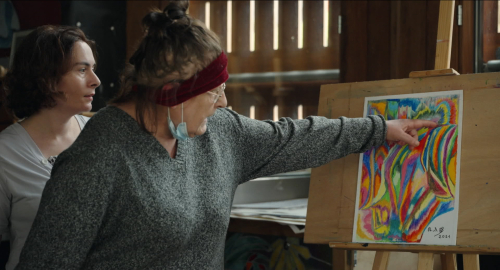
TS Production/Longride
MOVIE REVIEW
On the Adamant (2023)
In 2002 Nicolas Philibert scored a major international hit with “To Be and To Have,” a documentary about a year in the life of a small rural school. That film took pains to disguise that the school was small because it was for children who needed greater care and individual attention. Now Mr. Philibert has outdone himself and won the Golden Bear at this year’s Berlinale with “On the Adamant,” but here the people needing greater care and individual attention are adults. The Adamant is a day center for patients at a mental hospital serving central Paris, built on a repurposed barge permanently tethered on the Seine; and the atmosphere is one of gentle growth and support. Adults are not as inherently sympathetic as little children, of course. But over the course of the film sympathy for the tribulations of the attendees only grows. As a practitioner of gentle empathy Mr. Philibert is a master.
The patients range in age from their late teens to their 70s, though most of the older patients wear enough signs of rough living that it’s difficult to guess their true age. Many have “summer teeth” and for some their personal care leaves something to be desired, though the passing of time (the movie was shot during 2021) can be observed in how some of them start improving their personal hygiene. They also have a heart-breaking amount of self-awareness, such as the gentleman who explains that staying on his meds is more important than the power of speech, or the one who has developed a detailed theory about how he and his brother are the secret reincarnations of Theo and Vincent van Gogh. It’s sad and funny at the same time: The repeated scenes of a committee of eight people, without the patients or the staff differentiated, struggling to reconcile the tea counter cash box will ring true to anyone who's tried to organize anything by committee.
The overall tone on the Adamant is pleasant and not at all bossy, a refreshing change to most depictions of people working with the mentally unwell. Here everyone is quick to be kind. The way in which the tea counter manageress coaches one of the patients in how to serve a cup of coffee – not made easier by everyone having their own favorite mug – is the same kind of gentle reinforcement given to the kids making lunch in “To Be and to Have.” Except it's a grown man she is talking to here; and it's devastating to witness how nervous he is about this small basic skill most of us take for granted.
The movie doesn't get caught up in what went wrong for anyone, though some do discuss their histories with the camera. Instead Mr. Philibert and his crew were observers listening to people explain how they hold themselves together, or as they explain their thought processes or try to ask for something. Some people are very matter-of-fact about what daily life is like for them, while other people are more obviously struggling to keep agitation to a minimum. There are musical instruments, a film festival to arrange (very clever to include this) and the occasional impromptu concert such as the one which opens the film. The pictures drawn in art class are also discussed by the group; and it’s both amazing to see the talent on display as well as listen to the high level of analysis coming from the group. What it all adds up to is a reminder of the importance of human kindness for fragile people whatever their age. Was it the best movie of the Berlinale? No. But it was by far the kindest, and in this day and age that’s only to be rewarded.
Comments